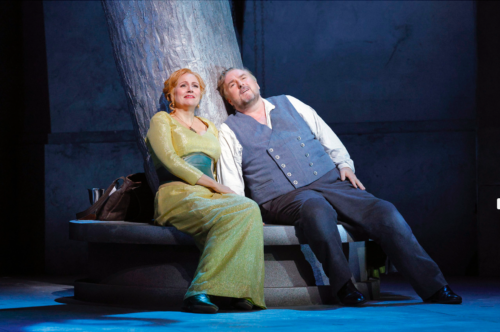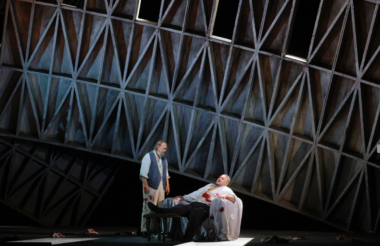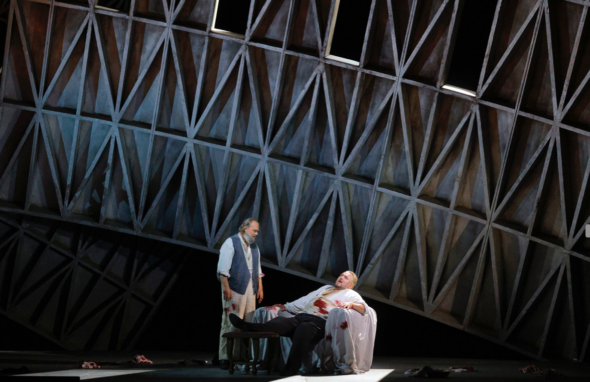 United States Wagner, Tristan und Isolde: Soloists, Chorus and Orchestra of San Francisco Opera / Eun Sun Kim (conductor). War Memorial Opera House, San Francisco, 23.10.2024. (HS)
United States Wagner, Tristan und Isolde: Soloists, Chorus and Orchestra of San Francisco Opera / Eun Sun Kim (conductor). War Memorial Opera House, San Francisco, 23.10.2024. (HS)

Production:
Director – Paul Curran
Sets – Robert Innes Hopkins
Lighting – David Martin Jacques
Fight director – Dave Maier
Chorus director – John Keene
Cast:
Isolde – Anja Kampe
Brangäne – Annika Schlicht
Tristan – Simon O’Neill
Kurwenal – Wolfgang Koch
King Marke – Kwangchul Youn
Shepherd / Sailor – Christopher Oglesby
Melot – Thomas Kinch
From the very first notes, what emerged from the orchestra pit for Wagner’s Tristan und Isolde was, appropriately, transcendent. In Wednesday’s second performance of five at San Francisco Opera, music director Eun Sun Kim led with care, intelligence and incandescent clarity to bring out all the nuances of the score. It was her first go at conducting this massive work, but the results were revelatory. Phrases took shape, dynamics fell into place, and tempos quickened and subsided naturally to create the overwhelming sense of yearning that infuses the music. The prelude emerged from a whisper, and pauses felt tentative. The ‘Tristan chord’ asked its question and hung in the air. The music gained momentum slowly, surging and ebbing, foreshadowing the character of the whole 4plus hours of the opera.
The glory of the opera, its music, was the vehicle that made the sometimes great, sometimes spotty singing and a less-than-incisive production come together in an unforgettable performance. The other preludes similarly laid the groundwork for what was to come with uncanny presence. The spooky scene-setting of Act II, with its surging chords interrupted by the sounds of distant hunting horns, worked its magic to bring extra tingling to the entire act. The slow-moving opening of Act III swelled lugubriously to set up what turned out to be the most glorious scene in the whole production (and it was not the Liebestod).
Plenty of individual efforts punctuated the orchestral glories, including several offstage moments, among them John Pearson’s solo in Act III on Holtztrompete (a wooden trumpet with brass mouthpiece and bell) and Benjamin Brogadir’s plangent cor anglais in the Act III shepherd’s songs. The horns galloped wonderfully offstage in Act II hunt music, and the echoes of the same calls from the pit hit just the right tone.
The best thing to say in favor of director Paul Curran’s staging, first seen at Venice’s Teatro La Fenice in 2012, was that it did not get in the way of the music. The set consists of two gigantic, curved walls that fit together in Act I to be the hull of an oversized ship, and turn to become convex for the garden in Act II. For some reason, they hung in midair to define Tristan’s castle in Act III. The pieces had the advantage, in all cases, of projecting the singers’ voices.
Interactions among the cast were more active than often seen in this opera, and especially good in moments of confrontation. On the other hand, the central moment of the opera – the title characters’ passionate tryst – fell flat visually as the singers barely held hands under a leaning, silvery tree.
The sets put the spotlight on the singers, and soprano Anja Kempe (last seen at San Francisco Opera as a remarkably agile Sieglinde in the 2012 Ring) had her best moments in the love duet. Her voice caressed the music with fluid softness, a trait overshadowed in other scenes by squally high notes and generally loud singing (which was unnecessary – Kim had the orchestra perfectly balanced to let the vocal lines shine). In her acting, Kempe made Isolde a temperamental Irish princess, revealing every pent-up frustration in Act I with Tristan, the hero who defeated her fiancé in battle only to be nursed back to health by her ministrations. He now brings her to Cornwall to be wed to the king.
The glory of the cast was Simon O’Neill’s Tristan. In this punishing role, his clarion tenor, all polished steel and glistening neon, rose to the occasion again and again. He never flagged, never seemed to be holding back, his vocal richness gaining extra depth and power with each succeeding scene. We could feel the inner thrills in the moment in Act I when a love potion has finally pushed the title characters to reach for one another (literally, in this staging, as they crawled slowly to come together as the music climbed to a climax).

O’Neill found a welcome liquidity in the Act II love duet, but the triumph of the evening came in Act III. His ability to act with his voice, his face and his body combined to make Tristan’s long scene of agony come to life. It shook me to the bones. Having been stabbed by his accuser at the end of Act II (after being caught kissing Isolde), he can barely rise from his blood-stained chair. Increasingly agitated at the possibility of Isolde returning, O’Neill gave voice to the character’s madness, rising hopes and hallucinations, with thrilling accuracy and a wealth of colors. It was staggering theater.
It is not often that anything can upstage Isolde’s Liebestod, which brings the opera to a close with some of Wagner’s most unforgettable music. On this evening, Kempe chose to sing much of it loudly, bleating some notes when a soft, beautiful line would have been safer and more appropriate. The orchestra, however, savored the music’s cohesiveness and yearning harmonies, finally resolving with satisfying richness in the final measures.
Among the vocal standouts in the rest of the cast, Annika Schlicht as Brangäne (Isolde’s servant and companion) fielded a resonant and fluid mezzo-soprano, her steadiness playing against Kempe’s impetuousness. Making her U.S. opera debut, she floated mellifluous warnings beside the Act II tryst. Baritone Wolfgang Koch, in his company debut, brought the most beautiful voice in the cast to Kurwenal (Tristan’s devoted attendant). His singing melded with O’Neill’s brilliantly in Act III.
As King Marke, bass Kwangchul Youn (recently Sarastro in last season’s The Magic Flute) made the most of his long Act III speech, begging forgiveness from Tristan whose lifeless body lay at his feet. He infused the music with more warmth and definition than we usually hear. Current and recent Adler Fellow tenors delivered small but colorful roles with flair: Christopher Oglesby’s refreshing directness animated the Act I sailor song, and Thomas Kinch’s haughty presence informed Melot’s brief part as the courtier who outs the lovers.
Harvey Steiman
